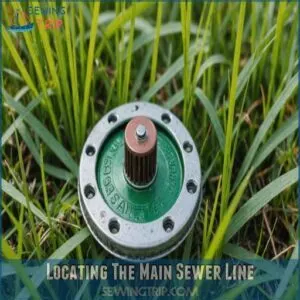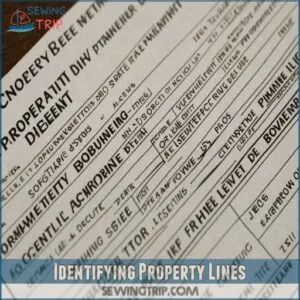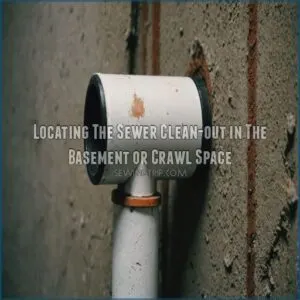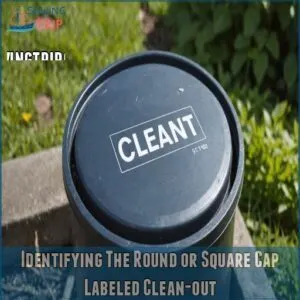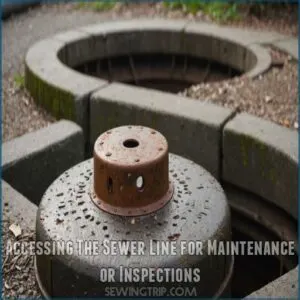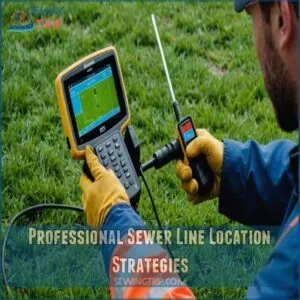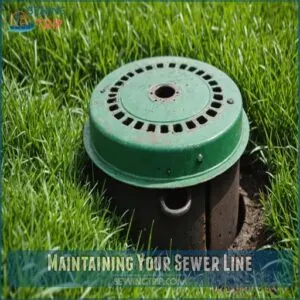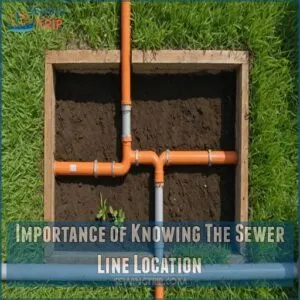This site is supported by our readers. We may earn a commission, at no cost to you, if you purchase through links.

If paperwork isn’t your friend, dial 811 to let utility folks mark it for you.
Take a detective-like stroll around your house, tracing drain pipes from sinks or toilets in the direction they exit.
You might even spot a clean-out cap, usually a circular or square cap labeled "clean-out," which offers clues.
Feeling adventurous? A bit of DIY sleuthing might reveal more than expected, offering a surprising peek into what lies beneath your feet. Curious about the next steps?
Table Of Contents
Key Takeaways
- Start by checking your home’s blueprints or contacting your city to access sewer maps, which can pinpoint the sewer line’s location.
- Call 811 to have utility lines marked before digging to avoid costly damage and stay safe.
- Trace drain pipes from sinks or toilets to follow the path of the sewer line and look for a clean-out cap, which offers clues.
- Consulting a licensed surveyor can provide legal clarity on your property boundaries and the sewer line’s precise location.
Locating The Main Sewer Line
To find the main sewer line on your property, start by checking with your city for access to sewer maps and contacting 811 to mark utilities.
You can also analyze the exit areas of your home’s pipes and track drain pipes from sinks or toilets to pinpoint the line’s location.
Checking With The City
Before you dig, someone should check with your city.
They might have a sewer map showing its location.
This can save you a lot of headaches.
Here’s what to do:
- Find your city’s public works or utilities department.
- Inquire about sewer map access and any permit requirements.
- Check for city regulations concerning sewer line work.
Knowing the sewer line’s history from construction records could be helpful.
Contacting 811 for Utility Locating
Imagine you’re ready to dig in your yard, but what lies beneath?
Before you start digging, make sure to think about the same dedication and hard work that skilled sewers bring to their craft, such as those who specialize in sustainable fashion techniques.
Before you begin, call 811!
This lifesaver guarantees utility line safety by marking where not to dig.
The 811 process is quick and essential, giving you peace of mind.
They’ll handle the underground mapping, preventing unwanted surprises and costly mishaps.
Analyzing Exit Areas of Pipes
When you’re trying to find the main sewer line, take a closer look at where pipes exit your house.
These exit areas can give you clues about pipe size, material, direction, connections, and age.
Think of the pipes like a roadmap leading to your sewer line.
By analyzing these spots, you can better understand where your sewer line might run.
Tracking Drain Pipes From Sinks or Toilets
To track drain pipes from sinks or toilets, start by examining the path of your toilet plumbing and sink drain routing.
You’ll often find a direct line leading to the main sewer.
Identifying pipe materials helps confirm connections—common ones like PVC or cast iron.
DIY sewer line tracing makes sense here, giving you insight into your home’s plumbing network.
Identifying Property Lines
Understanding your property’s boundaries is essential for locating the sewer line and avoiding costly mistakes.
By carefully reviewing property deeds, maps, and possibly consulting a surveyor, you’ll know exactly where your land begins and ends.
Reviewing Property Deeds
Got your eyes on identifying property lines?
Your property deed is a golden ticket.
It holds the legal description of your land, often with colorful terms like "easement details" or "metes and bounds," similar to how a Brother PE535 embroidery machine has various built-in designs for unique creations custom embroidery designs.
Think of it as a treasure map for your yard!
Sketches or detailed text help surveyor verification, ensuring you grasp those property boundaries clearly.
Analyzing Plat Maps
After checking out your property deed, the next stop is the plat map.
It’s like a treasure map for your land’s secrets, showing lot dimensions and property boundaries.
These maps help pinpoint shared boundaries with neighboring properties, so grab one from the local county office.
Knowing these details makes sure you’re not planting trees in your neighbor’s yard!
Using GIS Maps
Plat maps offer a visual overview, but for a more precise picture, explore GIS maps.
Websites like AcreValue and Google Maps’ features often display property lines, pulling data from public records.
This offers a handy, often free, way to check your boundaries.
You can even find specialized software and services, like sewer line GIS solutions, to help visualize and analyze sewer line data.
Remember, GIS accuracy varies, so don’t rely solely on it to settle Property Line Disputes.
It’s a great starting point though!
Consulting a Licensed Surveyor
When digital maps leave questions unanswered, calling a licensed surveyor can bring clarity.
They use precise survey methods to determine boundary accuracy and provide a legal description of your property.
Though surveyor fees might seem steep, avoiding property disputes is worth every penny.
They’re your go-to for understanding where your sewer line sits without guesswork or drama.
Finding The Sewer Clean-Out Point
To find your sewer clean-out point, look for a round or square cap labeled "clean-out" in the basement or crawl space.
This handy access point allows you to maintain or inspect your sewer line efficiently.
Locating The Sewer Clean-out in The Basement or Crawl Space
Digging into property lines is just the start.
Now, let’s talk finding that sewer clean-out, often hiding in your basement or crawl space.
Think of it as uncovering a buried treasure—use location tips to spot any identifying marks.
Check near the walls for easy basement access, or crawl spaces if you’re up for a little adventure.
Your clean-out awaits!
Identifying The Round or Square Cap Labeled Clean-out
Feeling a bit like a detective? You’ve got this!
Look for the round or square cap labeled "clean-out" near your house or yard. It’s usually plastic or metal, sticking out just above ground or in a utility area.
This cap is your ticket to easy sewer access—picture it as the gateway to smooth plumbing and quick fixes.
Accessing The Sewer Line for Maintenance or Inspections
Getting to the sewer line for maintenance or inspections is simpler than you might think.
First, locate the clean-out and remove its cap carefully.
Keep some tools handy:
- Wrench: For stubborn caps.
- Gloves: To keep things clean.
- Flashlight: To check the pipe’s condition.
- Snake or Auger: In case of minor blockages.
Be prepared for surprises!
DIY Sewer Line Location Strategies
When you’re looking to find the sewer line on your property, starting with DIY strategies can be both practical and rewarding.
By contacting the city for sewer maps, analyzing your pipe exit areas, and making sure to call 811 before digging, you can make sure a safe and efficient search.
Contacting The City to Access Sewer Maps
Finding your sewer cleanout is a great first step.
Next, contact your city’s department of public works or water resources.
Many cities offer online access to sewer maps, though there might be small map fees.
Check their website for the request process.
Accurate sewer maps can save you time and potential headaches, so it’s worth looking into.
Remember to call 811 before digging!
Analyzing The Exit Areas of Pipes
Start your sewer line hunt by analyzing exit areas of pipes.
Here’s a quick guide:
- Pipe Size: Larger pipes often lead to the sewer line.
- Pipe Material: Different materials can indicate main lines.
- Pipe Direction: Follow the path they take in the direction of the main exit.
- Pipe Age: Older pipes might be original installations.
Keep these points in mind to locate the main sewer line easily!
Calling 811 Before Digging
As you analyze exits of pipes, it’s time to think about safety first.
Before any digging, you should call 811.
This hotline connects you to professionals who’ll mark underground utilities to prevent risky accidents.
You can also use tools from a sewer line locator store to aid in your search.
Avoiding utility line damage isn’t just wise—it’s the law.
So, always call before you dig and steer clear of costly mishaps.
Professional Sewer Line Location Strategies
When DIY methods don’t cut it, calling in the pros is your best bet for locating sewer lines.
Professionals use cameras and sensors on cables to pinpoint pipes and identify issues like blockages or corrosion with precision.
Using Cameras and Cables to Locate Pipes
Switching gears from DIY methods, using cameras and cables becomes your go-to for pinpointing sewer lines.
With various camera types and cable lengths, you’ll navigate pipes like a pro.
For the best results, consider investing in a high-quality sewer camera, such as those found at sewer camera options.
Focus on image quality and sensor accuracy to get a clear view of the pipe.
It’s like playing detective underground, but without getting your hands dirty.
Just remember, keeping it precise makes all the difference!
Identifying Problems With Sewer Cameras
Ever wondered what’s lurking in your pipes?
Sewer cameras are your eyes underground, catching issues like root intrusion, pipe corrosion, and blockages.
Here’s how to make the most of these cameras:
- Camera Calibration: Make sure it’s set right for clear images.
- Image Interpretation: Spot problems early!
- Blockage Detection: Identify and tackle obstructions promptly.
Locating The Underground Sensor on The Camera
To track sewer line hiccups, focus on the underground sensor attached to the camera.
This little gadget helps pinpoint tricky spots with precision.
Think of it like a treasure map—accurate sensor readings guide you straight to blockages.
Troubleshooting becomes a breeze, ensuring signal strength is spot-on.
Get savvy with camera types for excellent accuracy and keep your sewer system in check.
Maintaining Your Sewer Line
Regular maintenance keeps your sewer line flowing smoothly, just like regular cleaning and oiling can keep a sewing machine running smoothly, especially for daily sewing machine users, preventing costly clogs and backups. Think of it like regular car maintenance – a little preventative care goes a long way!
Cleaning The Sewer Line With a Mainline Sewer Machine
Cleaning a sewer line can feel like wrestling with an octopus, but a mainline sewer machine simplifies the task.
These machines powerfully clear blockages, keeping your pipes flowing.
When considering this:
- Types: Go for electric or portable options.
- Safety: Wear protection.
- Cost: Consider renting; buying is pricey.
- DIY vs. Pro: Gauge your comfort level.
Inspecting Blockages With a Sewer Camera
Peering inside your sewer line? A sewer camera’s your gadget of choice.
Whether it’s root intrusion detection or analyzing those murky images, capturing the unseen becomes a cinch.
Remember, though, these cameras have limits.
Efficient blockage removal methods? Now, that’s gold.
Here’s a quick guide:
| Camera Type | Strengths |
|---|---|
| Basic | Cost-effective |
| HD | Clear images |
| Self-Level | Easy navigation |
| Pan & Tilt | Full coverage |
Installing a Sewer Cleanout for Easy Access
Ever considered DIY installation for sewer cleanouts? It’s like unclogging life’s mysteries.
- Location Matters: Pick an accessible spot near the main line.
- Cost Comparison: Weigh DIY costs against hiring pros.
- Routine Checkups: Keeps blockages at bay.
- Benefits: Enjoy hassle-free maintenance and fewer plumber calls.
It’s your first step to control and peace of mind!
Importance of Knowing The Sewer Line Location
Knowing where your sewer line is vital to avoid damaging it during landscaping or construction projects, which can otherwise lead to costly repairs.
Plus, being aware of its location makes maintenance tasks much smoother, ensuring everything in your home runs efficiently.
Preventing Damage to The Sewer Line During Construction or Landscaping
Before you even think about digging, grab those construction permits and check the sewer line depth.
This is key to avoiding any landscaping impact.
Also, consider the physical demands of the job, and take regular breaks to avoid bad habits like sitting with legs crossed.
Utility markings can be your best friend, keeping your lines clear.
To keep root intrusion at bay, plan your plantings wisely, ensuring roots don’t wriggle their way into your pipes.
Facilitating Repairs or Maintenance on The Sewer Line
Finding your sewer line’s location early on helps you stay ahead of any potential problems.
Whether you’re eyeing sewer line cleaning or tackling that challenging sewer line repair, knowing the exact spot saves you time, money, and stress.
It’s like having a flashlight in the dark—makes every maintenance task, from sewer line inspection to replacement, straightforward and manageable.
Ensuring Proper Functioning of The Sewer Line
Knowing your sewer line’s location is key to keeping things flowing smoothly. Here’s why:
- Preventative measures are easier with easy access.
- Spotting root intrusion becomes a breeze.
- Sewer line maintenance is simpler.
- Regular sewer line inspection avoids costly repairs.
A little knowledge goes a long way!
Frequently Asked Questions (FAQs)
How do you find a sewer line?
Imagine your drains as clues on a treasure map, leading to the main sewer line.
Follow them from sinks or toilets.
Or contact the city for sewer maps.
If uncertain, professionals can pinpoint it with cameras.
How do I access the sewer line on my property?
To access your sewer line, find a sewer cleanout on your property, often a capped pipe.
If unavailable, check near the foundation or consult a plumber.
Always call 811 before digging to avoid underground utilities.
Where is the sewer line located in a house?
The sewer line in your house typically runs straight from your drainage outlets to where it exits the building—either to a septic tank or the city’s sewer system.
Often, this is located in the basement or lowest level.
How do you mark a sewer line?
Ever tried following a breadcrumb trail, but for your yard?
To mark a sewer line, use flags or paint provided by 811 line locators.
This guarantees safety during projects, avoiding costly damage to underground utilities.
How to figure out where the sewer line is?
Check your property records or contact your city’s utility locator service.
They can pinpoint its location, saving you potential headaches (and maybe a broken shovel!).
Don’t forget to call 811 before digging!
How to find a sewer drain in a yard?
Measure twice, dig once," saves headaches later.
Start by locating any visible cleanout pipes, then follow their path.
Check with local authorities for maps, and before digging, call 811 to mark underground utilities, ensuring safety.
How deep are sewer lines buried?
Sewer lines are typically buried 12 to 36 inches deep.
This can vary depending on local regulations, climate, and soil type.
In colder areas, lines are deeper to prevent freezing, sometimes buried over 48 inches deep.
What does the main sewer line look like?
The main sewer line looks like a large, straight pipe that connects all your home’s drains to the municipal sewer or septic system.
It’s often made of PVC or cast iron, and typically has cleanout access points.
What are common signs of a sewer line problem?
When it rains, it pours—watch for slow drains, gurgling toilets, or wet patches in the yard.
Strange odors and backed-up water in sinks or tubs also signal potential sewer line issues needing prompt attention.
How deep is the typical sewer line buried?
Typically, sewer lines are buried 12-18 inches deep.
This can vary depending on factors like climate, soil type, and local building codes.
So it’s best to check with your local authorities for specifics.
Are there specific permits needed for sewer work?
Yes, permits are often needed for sewer work, as the main sewer line connects to the municipal system.
Check with your local building department to understand the requirements and avoid costly fines down the line.
How can tree roots affect sewer lines?
Tree roots can wreak havoc on sewer lines, cracking and blocking pipes over time.
Regular video inspections can detect root intrusion early, allowing you to address the issue before it becomes a costly headache.
What materials are sewer lines made from?
Sewer lines are like the hidden arteries of your property, typically made from durable materials like PVC, cast iron, or clay.
Understanding their construction helps you maintain and troubleshoot issues with your home’s plumbing.
Conclusion
Don’t fret if you can’t find the sewer line right away—it’s often hidden underground.
But with a bit of sleuthing, you’ll soon track down that all-important sewer line on your property.
Whether it’s checking old blueprints, contacting your local utilities, or spotting that telltale clean-out cap, knowing where your sewer line runs is key to preventing costly repairs and keeping your home’s plumbing flowing smoothly.
Finding the sewer line may take some effort, but it’s well worth the investment to protect your property.

